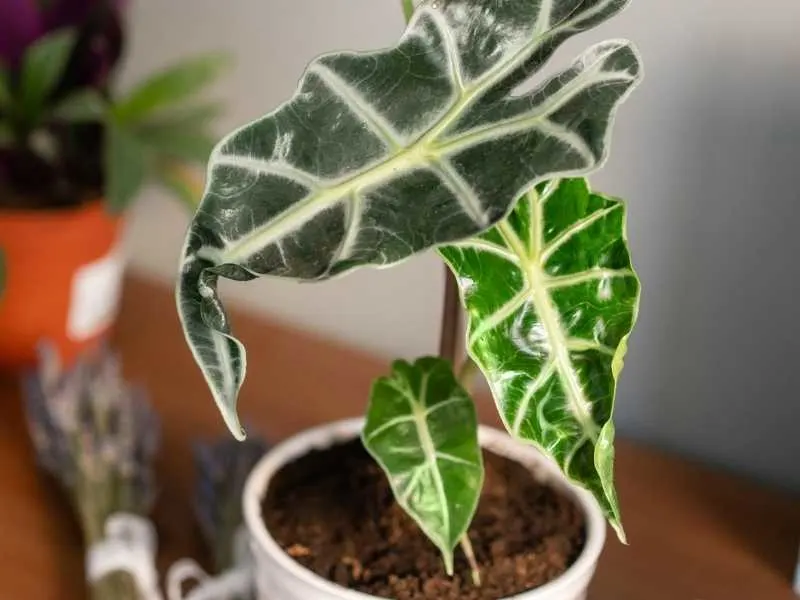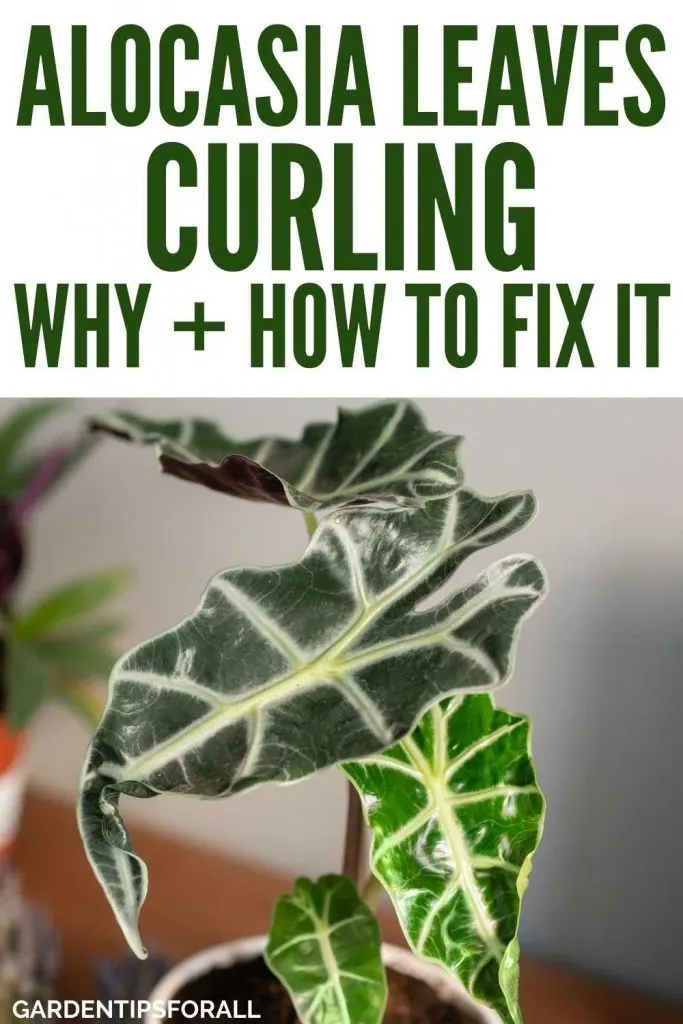Alocasia Leaf Curling – 8 Reasons and How to Fix It
Alocasia is a fond household plant that people love for its tropical vibes. It is one of the main types of elephant ear plants. It is clear where elephant ear plants get their name. They get their name from the magnificent size of their elephant-shaped or heart-shaped leaves.
Whether you are putting them up indoors or outdoors or growing them in a pot or a garden bed, they are just a lot of fun and very rewarding to grow.
That being said, growing them could be a bit challenging as you may have to deal with leaves curling, drooping or turning yellow among other issues.
So, you may be wondering, why are my alocasia leaves curling?
Alocasia leaves curl due to environmental issues or lack of proper care. Some possible reasons for curling could be overexposure to the sun, low humidity, temperature stress, low lighting, over-fertilization, under watering, overwatering or pest infestation.

Curling is quite a common phenomenon, so don’t be alarmed to see your alocasia cup or curl at the tips of the leaves or the margins. To keep your alocasia plants looking healthy as ever, you need to know why curling happens in the first place and what to do about it.
Related Article:
- 15 Alocasia Varieties with Names and Pictures
- Why Do My Elephant Ear Leave Drip Water?
- Is Elephant Ear Plant Edible?
- Sansevieria Leaves Splitting – Why + Solutions
Your Alocasia Leaves Curling – 8 Reasons and Possible Solutions
Your lovely alocasia leaves curling can be very upsetting, but worry not; we have a few tips that are sure to come in handy when you notice they are not looking as healthy or gorgeous as they should.
#1. Underwatering
Alocasia plants are tropical plants, and they need adequate moisture to survive. Not getting enough water could result in leaf curling or drooping. If you don’t take care of the leaf curling issue, your leaves will become dry and crispy. Eventually, they could die.
How to Fix It
Elephant ear plants drink a lot of water and thrive well when you provide sufficient moisture. You should keep a check on the moisture content of the soil often and ensure that the soil is wet.
Your watering schedule should be bang on to ensure the plants receive 2 to 3 inches of water each week. Water once a week and never let your soil dry out. During summers, you should water every day.
#2. Overwatering
Overwatering is one of the leading causes of alocasia leaves curling. If you are not on top of the basics of watering your alocasia elephant ears, you will land up with overwatering issues.
An obvious sign of overwatering is that the leaves turn yellow. Excess moisture can also lead to insufficient air circulation, which could cause root rot. The leaves may also start to wilt or develop brown spots.
How to Fix It
Your elephant ears may love water, but that doesn’t mean you should drown your plant in water and saturate the soil. If you notice signs of overwatering, you should let the first 2 inches of the soil dry before you water again.
You should first cut off the rotten roots and damaged leaves, drain out all the excess water that is pooled up, and repot the plant to a new container.
I suggest you use a pot with drain holes at the bottom to eliminate excess water.
#3. Low Temperature
Alocasia plants are tropical plants, and so they prefer warmth. They prefer warm temperatures that range from 68 degrees and 85 degrees Fahrenheit. They cannot survive when the temperature drops below 60 degrees.
If your alocasia is currently in a cold location, move them to a room in which the temperature is higher.
Chilling weather, freezing climate and cold draughts are something you don’t want to expose your alocasia plant to.
If the room in which you have placed your plant is really cold or you live in an area where cold weather is the order of the day, your alocasia will undergo temperature stress, resulting in leaf curling.
How to Fix It
You should keep your plants away from cold weather and biting chillness. During winters when they are dormant, you can dig up the tubers, wrap them in a paper bag and keep them in a dry, cool spot. You should wait until spring to repot the plant.
#4. Low Humidity
Like other tropical plants, alocasia plants do well in high humid conditions. The humidity should be at least 60 percent for them to grow well.
If you live in areas where the temperature can get really low (under 30 Fahrenheit degrees) or is prone to severe winters, the air will be dry and moisture content in the air will be less.
Lack of humidity makes the alocasia lose water. The absence of moisture makes the leaves curl.
How to Fix It
There are a few things you could do to enhance the humidity levels.
One is to make use of a humidifier in your home to mimic the tropical environment. This will help to prevent your alocasia leaves from curling. You can also do misting to increase the humidity level in the air.
Consider placing your alocasia plant in a pebble tray or humidity tray with water in it. It will keep the air moist and put a stop to alocasia leaves curling.
#5. Over-Fertilization
Alocasia plants are heavy feeders and need the right fertilizers applied at regular intervals so that they can grow to their full potential.
However, some people may overdo it and supply their alocasia with more nutrients than is required. This is common with people who grow these plants in pots.
Using the wrong fertilizer, applying too much fertilizer, fertilizing when the plant is dormant or getting the fertilizer on the leaves could lead to issues.
Leaf curling is a sign of over-fertilization. Excess nutrition and salt build-up around the roots burn the root system and affect the alocasia leaf cells.
How to Fix It
Consider using a water-soluble, slow-release 20-20-20 fertilizer and feed the plants once every two weeks during the spring and summer, which are the growing months for the plant.
In winter, the plant will be dormant, so I suggest you don’t fertilize your alocasia during the winter.
This will ensure that your plant is back to normal.
In case you have overfed, do not worry. Simply cut off the curled leaves, give the soil a complete flush with water, and wait for them to regenerate as good as new.
You could also repot the plant if you don’t want to deal with further leaf problems.
#6. Potassium Deficiency
Potassium is a vital nutrient that helps your alocasia plant grow large, robust and glossy leaves.
If you see curling in the lower and older leaves, the reason could be potassium deficiency. If you don’t take steps to get this fixed, the leaves will eventually dry up and die.
How to Fix It
You can solve this issue in two ways: using organic fertilizer or inorganic fertilizer.
If you are all for a natural solution, then feed your alocasia plants with organic fertilizers like banana peels, comfrey liquid, or seaweed.
If you want to go with inorganic fertilizers, then fertilizers such as potassium sulphate, potassium chloride, and potassium nitrate are really good potassium fertilizers that will do wonders for your plants.
Remember, you should apply them only during the spring and summer and provide an adequate amount of water to your plant so that the nutrients are well absorbed.
#7. Pest Infestations and Insect Attacks
No matter how careful you are, pest infestations are unavoidable. Just because you have your alocasia indoors, doesn’t mean you should rule out pest attacks! The insects can get into your house and get on your plants.
Alocasia is most prone to attack by aphids, spider mites, and mealybugs. What harm can these insects do? They will damage the plant by sucking out vital juices and harming the plant cells. This is how leaf curling starts.
How to Fix It
You should first closely inspect the plants for signs of pest infestation. If you notice any webbing, use a horticulture soap or an alocasia-friendly insecticide soap to get rid of insects and prevent any webbing issues in the future.
Insects are attracted to dusty plants like a magnet! You should clean your alocasia leaves regularly to keep them dust-free.
Another remedy is to use neem oil to remove pests and prevent them from damaging the leaves.
#8. Overexposure to Sunlight
Alocasia plant leaves could curl when exposed to too much light. Excessive light makes the plant overactive.
The energy created from too intense lighting conditions is something the plant cannot handle. The leaves will turn crisp and start to curl.
How to Fix It
I suggest keeping the plant in a spot where it can get bright, indirect sunlight for around 6 to 8 hours every day.
Keeping the soil wet and moist and misting regularly will also help in preventing the temperature from rising too high.
Caring Tips for Your Alocasia Plant
If you want healthy-looking and vibrant alocasia leaves, you must take good care of your plant. Taking care of your alocasia plant may be a challenge, but you can do it.
Here are a few tips to help you get started on the right footing.
- Keep your alocasia plant in a room with bright, indirect light. Protect them from intense and direct sunlight.
- Stick to a proper watering schedule. And water your alcasia plants only when the top 2 inches of the soil is dry.
- Elephant ear plants cannot thrive in cold weather. You should bring them in during winter.
- Ensure a high level of humidity in the air where the plant is kept.
- Provide the right amount of fertilizer in their growth period.
- Clean the leaves monthly to remove dust and pests.
- Make sure that your alocasia plant has ample space to breathe and grow. You should repot/replant once every 1-2 years.
Final Thoughts on Alocasia Leaves Curling
As you can see, alocasia leaves could curl due to several reasons. It could be because of issues with lighting, watering, nutrient deficiency, improper fertilizing, temperature stress, humidity issues, pest or insect infestation.
If you provide your plant with the proper conditions, they will grow lush and healthy. Despite your TLC, if you notice any sign of curling, this guide will come in handy to get to the root of the issue and fix it promptly. Your alocasia deserves it! Good luck!

